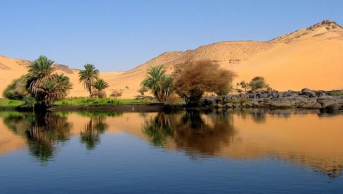Oslo+21 and Water Problems in Palestine: A Story of Failure

More than two decades passed since the landmark deal between Israelis and Palestinians, namely the Oslo Accords. Water has always been a focal point in relations between the two. The World Bank has recently announced that the water scarcity in Gaza Strip is getting dangerously alarming. The West Banks represents a similar setting. The water situation in Palestine today made more people ask why did the Oslo Accords failed in contributing to solutions of water related problems in Palestine.
Oslo Agreement’s (1993) major stipulations on water issue are included in the Annex III , the Protocol On Israeli-Palestinian Cooperation in Economic and Development Programs. It reads: “The two sides agree to establish an Israeli-Palestinian continuing Committee for Economic Cooperation, focusing, among other things, on the following:Cooperation in the field of water, including a Water Development Program prepared by experts from both sides, which will also specify the mode of cooperation in the management of water resources in the West Bank and Gaza Strip, and will include proposals for studies and plans on water rights of each party, as well as on the equitable utilization of joint water resources for implementation in and beyond the interim period.” Oslo Agreement was probably the most dramatic political event in that year which also brought Nobel Peace Prize to its fathers, namely Yasser Arafat, Yitzhak Rabin and Shimon Peres.
Based on the above framework, the water regime between Israel and Palestine was materialized in 1995, through and after the process known as the Oslo II Accords. The Oslo II Accord was first signed in Taba, Egypt; by Israel and the Palestine Liberation Organization on 24 September 1995. Four days later, on 28 September 1995 it was re-signed in a ceremonial fashion by Israeli Prime Minister Yitzhak Rabin and PLO Chairman Yasser Arafat and witnessed by US President Bill Clinton as well as by representatives of Russia, Egypt, Jordan, Norway, and the European Union in Washington, D.C.
Water has been dealt within the scope of the detailed Article 40 of the Annex III of the Oslo II Agreement, which, inter alia, reads:“1. Israel recognizes the Palestinian water rights in the West Bank. These will be negotiated in the permanent status negotiations and settled in the Permanent Status Agreement relating to the various water resources.2. Both sides recognize the necessity to develop additional water for various uses. 3. While respecting each side's powers and responsibilities in the sphere of water and sewage in their respective areas, both sides agree to coordinate the management of water and sewage resources and systems in the West Bank during the interim period, in accordance with the following principles: a. Maintaining existing quantities of utilization from the resources, taking into consideration the quantities of additional water for the Palestinians from the Eastern Aquifer and other agreed sources in the West Bank as detailed in this Article. b. Preventing the deterioration of water quality in water resources. c. Using the water resources in a manner which will ensure sustainable use in the future, in quantity and quality. d. Adjusting the utilization of the resources according to variable climatological and hydrological conditions. e. Taking all necessary measures to prevent any harm to water resources, including those utilized by the other side.f. Treating, reusing or properly disposing of all domestic, urban, industrial, and agricultural sewage. g. Existing water and sewage systems shall be operated, maintained and developed in a coordinated manner, as set out in this Article. h. Each side shall take all necessary measures to prevent any harm to the water and sewage systems in their respective areas. i. Each side shall ensure that the provisions of this Article are applied to all resources and systems, including those privately owned or operated, in their respective areas.”
These principles were supported by a number of commitments from both sides and a new and permanent “Joint Water Committee” (JWC). JWC would be responsible mainly for coordinated management and protection of water resources as well as water and sewage systems, but only in the West Bank. Also, the tasks of exchange of information relating to water and sewage laws and regulations, overseeing the operation of the joint supervision and enforcement mechanism, resolution of water and sewage related disputes, cooperation in the field of water and sewage, arrangements for water supply from one side to the other, and monitoring systems were to be handled by the JWC which be comprised of equal members from both sides and would reach decisions through consensus.
Despite all the applause created by the Oslo process, and notwithstanding the quite detailed quantified allocations and institutionalization (i.e. JWC) that the Agreement included, three notable problems in the Agreement did prevent amelioration of the water related problems in Palestine and even further aggravated them in time. First is the exclusion of Gaza Strip and continued Israeli dominance on nearly 60% of the West Bank (Area C) in the agreement. To put it simply, Gaza was not able to use water from the West Bank, and should find all of the water it requires from its tiny territory. In other words, the Agreement was partly “born dead” from the outset. Second, Agreement did not take into account of the dynamic character of the nature and population. Fixed quantities for allocation did not reflect the rapid changes in population, water demand, natural changes in water availability.Calls for a more flexible deal did mushroom soon after the problems become more visible. Third, contrary to what was envisaged by the creation of the JWC, Israel’s domination in water projects continued through its effective veto power in JWC. Although the JWC required a shared understanding to be reached, Israel, in practice, usually conditioned approval of Palestinian projects on Palestinian approval of projects in settlements. Therefore, Palestinians were forced to unwillingly accept a number of projects that Israel proposed in settlement areas, just to secure new water sources in needy areas in Palestine. Undoubtedly, Palestinians were not able to exercise such veto power.
To conclude, Oslo Accords cannot be seen as a great step forwardin terms of water issues between Israel and Palestine. The current devastating water crisis in Gaza and enduring challenges in the West Bank made it apparent that the Oslo Process, which was nothing more than a perpetuation of unfair water regime in Palestinian territories, did create more problems than it solved in the water realm.








